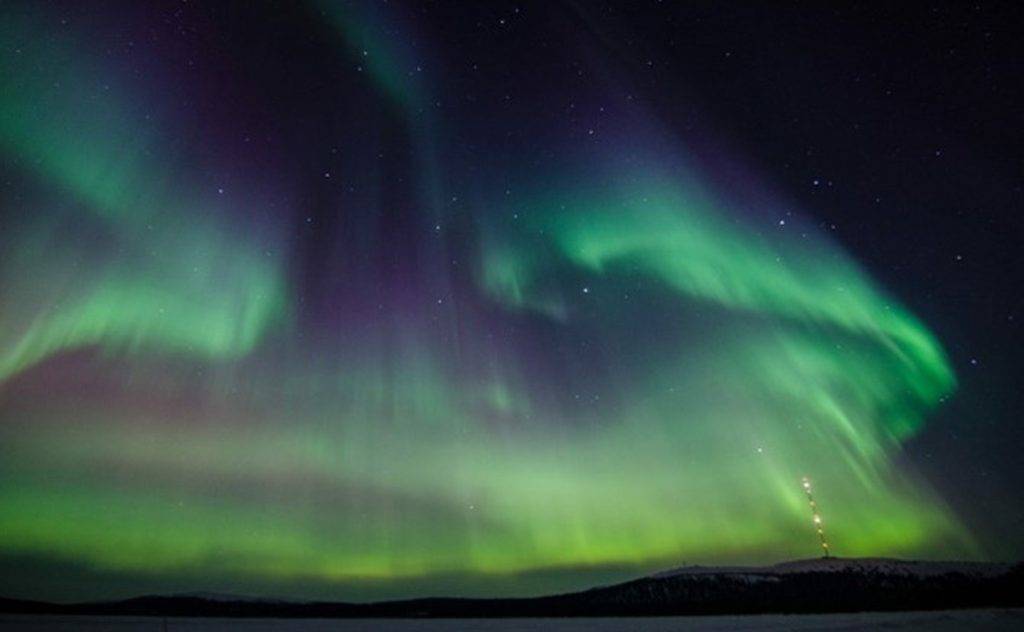What is a polar aurora and how does it appear?
It’s from the Sun that the aurora borealis are born. Our star continually ejects electrically charged particles into space. These particles, called ions, are continually moving away from the surface of the Sun, creating the “solar wind”.
Auroras are light shows that occur when there is an interaction between this flow of particles and the gases in the Earth’s upper atmosphere (most often oxygen and nitrogen). This interaction causes the atoms and molecules of the gas to become “excited”, generating flashes of light that fill the sky with veils of colour.
The Earth’s magnetic field guides the ions towards the poles, which is why the auroras are called polar auroras. In the northern hemisphere, they are known as the aurora borealis, and in the southern hemisphere as the aurora australis. These auroras are therefore not just a visual spectacle, but also a view of the interactions between the Sun and the Earth.
The importance of monitoring the polar aurora
Studying the aurora is vital if we are to gain a better understanding of their consequences and disruptions:
- Scientific research and understanding
Observing the aurora helps us to better understand space weather, in particular solar cycles and the dynamics of the Earth’s space environment. They provide information about the Earth’s magnetic field and solar phenomena, crucial for our protection against potentially dangerous solar radiation.
In addition, particles from solar storms penetrate deep into matter. As living beings are made of matter, there is a risk for humans.
It should be noted that in commercial aviation, flight crews and passengers are also subject to slightly more ionising radiation than on the ground, particularly at high latitudes. It should be noted that in commercial aviation, flight crews and passengers are also subject to slightly more ionising radiation than on the ground, particularly at high latitudes.
Today, new regulations require regular monitoring of the doses received. This study will increase our knowledge of how our planet and the surrounding space work, and offers a unique opportunity to study fundamental physical processes and electromagnetic phenomena.
Finally, on Earth, magnetic storms have the capacity to generate direct electrical current in large high-voltage lines. This can lead to overheating in substation transformers and major power shortage. During a solar flare in 1989, a historic blackout affected no fewer than six million people in Quebec. The associated polar auroras were observed as far away as Texas.
- Impact on technologies
The solar storms that sometimes accompany the aurora can also have a major impact on technology, disrupting power grids, satellite communications and navigation systems. By monitoring the aurora, we can anticipate these solar storms and take steps to protect our technological infrastructures.
Understanding the phenomena associated with the polar aurora is therefore relevant to space exploration and to the safety of astronauts and spacecraft.The knowledge acquired can help develop strategies to protect equipment and people on space missions.
The Aurora project to monitor the polar aurora
The Aurora mission is part of ESA’s space security programme to develop and put into orbit a network of 4 satellites, the main objective of which is to monitor the Earth’s auroral oval for operational space weather applications.
This monitoring is extremely important, as it enables us to observe the impact of the solar wind and coronal mass ejections (CMEs) on the magnetosphere and the Earth’s upper atmosphere. These impacts can trigger geomagnetic storms and substorms when they hit the Earth.
Auroral emissions (optical, in the far ultraviolet and in X-rays) are a direct manifestation of the physical processes that occur when the magnetosphere reacts to the solar wind and the plasma flows from coronal mass ejections.
The AOSI (Aurora Oval Spectro Imager) instrument on board the AURORA mission will strengthen France’s leadership in space meteorology and unite the scientific community around this project.
Absolut System is the designer of the French spectral imager (miniaturised hyperspectral camera) for this mission, and leads the international consortium developing this instrument. It provides cryogenic expertise and payloads.
To know more about Absolut System and its cryogenic expertise, click here.
